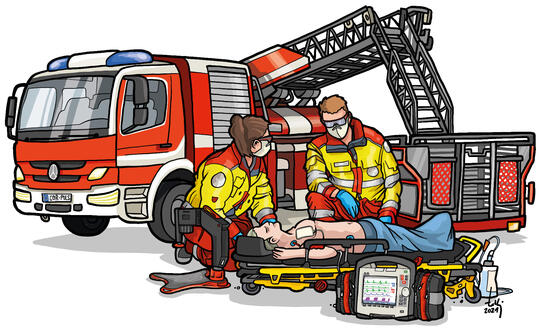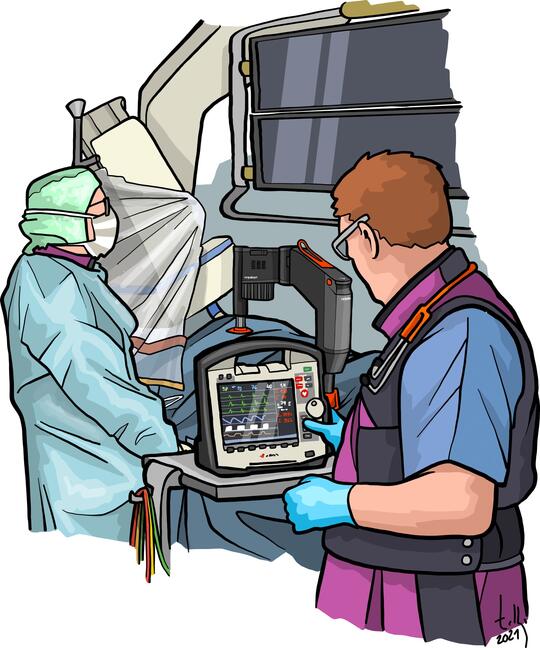Perfect partners on duty
Missions in the old town are always challenging. Narrow streets with parked cars, steep stairs with narrow steps and tight turns. As well as that, the rooms in the old buildings are often very small. Kim and Max don't have a good feeling when the control centre directs their ambulance to an address in the old town. An unresponsive person. When they arrive at the address the house looks to be over a hundred years old.
They grab their emergency backpack and mobile medical device from the vehicle. An panicked woman is waiting for Kim and Max at the front door. “You have to go right to the top. My son has collapsed and is unconscious”, she tells the ambulance crew. Kim and Max make their way up stairs in the old building.
The patient lies in a small room, cooped up between the edge of the bed, the radiator and the sloping roof. He is approx. 30 years old, quite overweight and showing signs of cyanosis. They quickly determine that he is in cardiac arrest. They know that the required resuscitation will not be easy because of the location.
The corpuls3 is ready for use in just a few simple steps. The characteristic depiction of ventricular fibrillation appears on the monitor display. “The guidelines state that defibrillation must be performed for both ventricular fibrillation and pulseless ventricular tachycardia” explains Kim. The sooner the defibrillator is ready for use and charged, the greater the chance of saving the patient's life.
The defibrillations do not have the desired effect. It is foreseeable that chest compressions will have to be continued for some time. As Kim and Max are on their own until the emergency physician team arrives, a third colleague would be worth their weight in gold. "In these kind of situations we can fall back on the corpuls cpr" says Max. With a simple Bluetooth connection just like the handsfree system we all use in our cars, corpuls cpr becomes the extended arm of the corpuls3. Together they are perfect partners in action when resuscitation is required.
A flashing Bluetooth symbol on the display of the corpuls cpr signals that the two devices are ready for coupling. When the symbol lights up continuously, the connection is established. Kim presses the "Connect" key on the corpuls3. Successful pairing is confirmed in the red field on the defibrillator user interface. From now on, all corpuls cpr settings can be made via the corpuls3: compression rate and depth and the CPR mode. Standardised alarm management also ensures that monitoring alarms from both device components appear on the corpuls3 8.4‘‘ display. “This allows us to react immediately to all alarms and control the situation from one point” explains Kim. The risk of accidentally setting different values on the two devices is virtually eliminated.
The corpuls cpr is ready for use very quickly. Max and Kim have worked with this device before. While Kim performs manual chest compressions, Max connects the arm of the corpuls cpr to its board. On command, they then lift the patient's head and upper body slightly in order to slide the board of the corpuls cpr under the patients back. Then they position the arm of the corpuls cpr and press the start key. The entire maneuver takes just three seconds.
The synchronization of corpuls3 and corpuls cpr is a critical factor in this mission so that the resuscitation can be carried out in accordance with the guidelines despite the unfavourable setting.
The corpuls3 reports automatically after two minutes to start the next analysis. “To do so we have to interrupt manual chest compressions” says Max. You pause by selecting "Stop mCPR" or "Start mCPR" on the device.
The analysis shows that further defibrillation is required. Kim presses the "Load" softkey. The defibrillation energy required is immediately charged. By then pressing the „Shock“ key, the chest compressions being carried out by the corpuls cpr automatically pause for immediate shock delivery and then start again after shock delivery.
Such defibrillations can literally save the patient's life. However, this action is not safe for emergency services. If, for example, Max did not interrupt the manual chest compressions to deliver the shock, there would be a risk of an (unwanted) power surge. The option to control the corpuls cpr via the control panel of the corpuls3 therefore means a significant increase in safety for the rescue team.
The emergency physician has now arrived on scene. The patient's condition has stabilised to a point where transport can be risked. The receiving hospital has a cardiology department. The travel time is calculated at around 20 minutes. However, the patient must first be moved from the attic to the ambulance, which is parked in front of the house. "Transporting him down the building‘s steep, narrow stairs would not be the gentlest option" says Max. Therefore, after consulting the emergency physician, he requests the turntable ladder from the local fire department. The cage on the ladder has a stretcher holder. So it is not a problem to gently move the patient to the ambulance using the turntable ladder under continuous monitoring and in constant readiness for resuscitation.

Max starts the ambulance and drives off. During the transport, Kim and the emergency physician monitor the patient. They are belted into their seats in the back of the ambulance, as per the regulations. However, they would still be able to immediately restart resuscitation at any time, should the patient's condition require so.
They don't have to get out of their seats to do it. “Up until now, chest compressions in a moving ambulance always had to be done while standing. That always carries a very high risk of injury for us” explains Kim. They would be unbuckled and have no chance of securing themselves in a sudden braking maneuver. With corpuls cpr this is not an issue. Thanks to the synchronisation of the devices, Kim and the emergency physician can control the continuation of resuscitation, including defibrillations if so required, from their seats. "If we had decided to fly the patient to the clinic in a rescue helicopter, this would also have been possible with the support of corpuls cpr" explains emergency physician Wolfgang Böhlert.
“The significantly smaller space and minimal height in the cabin compared to an ambulance greatly reduces the working area, especially in the event of a resuscitation. But neither are a problem for the corpuls cpr" said the physician. “With the help of the Bluetooth connection to the corpuls3, all parameters and settings are kept in check via remote control even during flight."
The transport to the clinic went without any further incident. Kim, Max and the emergency vehicle team handover the patient to the doctors and nurses in the intensive care unit. Angiography and catheter intervention should be some of the next steps. This illustrates how the corpuls3 and corpuls cpr team also has its place in everyday clinical practice.
X-rays or computed tomography scans are needed, for example, to track down the cause of the patient‘s critical condition. Such diagnostic procedures sometimes take place under continued resuscitation. The radiation exposure that occurs during such procedures is a risk for nursing staff that should not be underestimated. The corpuls3 and the corpuls cpr make it possible to carry out such procedures in compliance with occupational safety.
The European Resuscitation Council (ERC) recommends* using mechanical chest compression devices, such as the corpuls cpr, during angiography under resuscitation. In the cath lab, on the other hand, complications can arise during the treatment of patients, which sometimes require resuscitation measures. The sterile environment and limited personnel are not ideal for resuscitation with manual chest compressions. In such situations, synchronised devices are the best solution for working quickly, to a high quality and efficiently in terms of personnel.

While the cardiology specialists have taken over the intensive care of the patient, Kim and Max are waiting for their mission documentation. All measures, events, setting parameters and measured values are required for this. The task of gathering all the data from the various devices used and logging it legally in the mission log can be timeconsuming.
The synchronisation of corpuls3 and corpuls cpr also helps Kim and Max here. "The corpuls3 as the central control unit provides us with all the necessary mission data for both devices at the push of a button" says Kim happily. This is great not only for billing purposes, but also for debriefings and training sessions. You can therefore rely on these perfect partners in action, even after the mission.
PERFECTION THROUGH AUTOMATION
Studies show that pauses of less than ten seconds before and after defibrillation and a chest compression fraction greater than 60% are associated with better patient outcomes. The European Resuscitation Council (ERC) therefore recommends reducing interruptions to a minimum. They also recommend shortening the pause between chest compressions to less than five seconds when using a manual defibrillator.
In practice, this means not only high trai-ning requirements, but also the extreme concentration of the rescue workers. However, if synchronized devices such as the corpuls3 and the corpuls cpr are used, the hands-off time and the rhythm analysis can be reduced. The variable setting options guarantee compliance with the ERC guidelines scientifically recommended resuscitation process. Even during operation in semi-automatic (AED) mode by inexperienced personnel, synchronization guarantees a guideline-compliant procedure with reduced hands-off times in the event of defibrillation.
PEDIATRIC EMERGENCY
Resuscitation of a child is one of the most stressful emer-gency situations possible. The synchronised use of corpuls3 and corpuls cpr can also be of unparalleled help here. Due to the small body size of the child – fewer rescue workers can work directly on the patient than with an adult. The remote controlled use of the corpuls cpr via the control panel of the corpuls3 reduces the number of rescuers required. This helps to support an orderly workflow even in a confined space. Synchronisation also creates the opportunity for rescuers to undertake other important tasks such as looking after the child's parents.
These articles might also interest you
 corpuls in use
corpuls in useStarcode - Emergency on board of "Mein Schiff 2"
On the "Mein Schiff 2", the medical team is always prepared for emergencies, despite the holiday mood. corpuls in use
corpuls in useDOWN UNDER – Queensland Ambulance Service
3,800 paramedics are on duty every day with state-of-the-art equipment in often extreme conditions for almost 5 million residents. corpuls in use
corpuls in useEmergency rescue at the Oseberg oil field in Norway
Why the probability of surviving a cardiac arrest in the middle of the North Sea is almost higher than on the mainland corpuls in use
corpuls in useCompetence Centre for Rescue Services in Peru
With the training of rescue service professionals, the rescue system in Peru and Bolivia is optimised sustainably. corpuls in use
corpuls in useAir Zermatt – RESCUE AT 4,000 METRES
Extreme Alpine Air Rescue - with 11 helicopters, Air Zermatt flies 2000 rescue missions per year corpuls in use
corpuls in use"SMUR Pédiatrique" – CHILDREN RESCUE SERVICE IN PARIS
Paris. City of love - and crowded streets. We accompanied the "SMUR Pédiatrique", a rescue service especially for children, on a mission.











